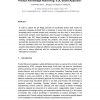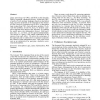AUSAI
2005
Springer
15 years 1 months ago
2005
Springer
In this paper, I will show how a controlled natural language can be used to describe knowledge for the Semantic Web and discuss the formal properties of this language. At the firs...
ACMICEC
2005
ACM
15 years 1 months ago
2005
ACM
In order to capture the full fledge semantic of complicated product data model, the expressive language ALCNHR+ K(D) is introduced. It cannot only be able to represent knowledge a...
WISE
2005
Springer
15 years 1 months ago
2005
Springer
Abstract. Answering a query over a group of RDF data pages is a trivial process. However, in the Semantic Web, there is a need for ontology technology. Consequently, OWL, a family ...
LICS
2005
IEEE
15 years 1 months ago
2005
IEEE
In recent work Baader has shown that a certain description logic with conjunction, existential quantification and with circular definitions has a polynomial time subsumption pro...
ADC
2006
Springer
15 years 1 months ago
2006
Springer
Query answering over OWLs and RDFs on the Semantic Web is, in general, a deductive process. To this end, OWL, a family of web ontology languages based on description logic, has be...
SEMWEB
2007
Springer
15 years 1 months ago
2007
Springer
Classical ontologies are not suitable to represent imprecise nor uncertain pieces of information. As a solution we will combine fuzzy Description Logics with a possibilistic layer....
KI
2007
Springer
15 years 1 months ago
2007
Springer
General action languages, like e.g. the Situation Calculus, use full classical logic to represent knowledge of actions and their effects in dynamic domains. Description Logics, on...
KI
2007
Springer
15 years 1 months ago
2007
Springer
The relationship and possible interplay between different knowledge representation and reasoning paradigms is a fundamental topic in artificial intelligence. For expressive knowl...
ER
2007
Springer
15 years 1 months ago
2007
Springer
The goal of this article is to formalize Object Role Modeling (ORM) using the DLR description logic. This would enable automated reasoning on the formal properties of ORM diagrams,...
FUZZIEEE
2007
IEEE
15 years 1 months ago
2007
IEEE
— The Semantic Web can be viewed as largely about “Knowledge meets the Web”. Thus its vision includes ontologies and rules. A key requirement for the architecture of the Sema...



